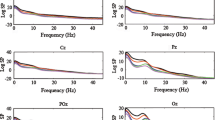Abstract
The contribution of genetic factors to the formation of the neurophysiological mechanisms of cortical-subcortical integration was studied in 12 pairs of monozygotic and five pairs of dizygotic twins (aged 18–25 years). Intrapair similarity of the nature of spatial interactions between bioelectrical activity in the cerebral cortex, assessed from different combinations of statistical interactions of EEG from 16 monopolar recordings, was assessed in each pair of twins (and among 544 non-related pairs of subjects in both groups). The results suggest a high level of general population invariance and relatively small inherited and phenotypic variability in the morphofunctional systems making up the major neurophysiological mechanisms of brain integration as a whole. The ontogenetic formation of stem and subcortical regulatory structures, which have a leading role in the systems combination of different parts of the brain into a single formation, appears to occur in all individuals by the same principle, as disturbance can apparently affect the fundamental monomorphic features of the species. In turn, we might expect to find large interindividual variability in the establishment of interregional connections of the neocortex, the role of inherited and environmental factors being different in the processes forming long and relatively short intercortical interactions.
Similar content being viewed by others
REFERENCES
O. S. Adrianov, Organizational Principles of Integrative Brain Activity [in Russian], Meditsina, Moscow (1976).
O. S. Adrianov, “Brain architecture and the individuality of personality (identification of questions),” Usp. Fiziol. Nauk., 4,No. 3, 25–39 (1993).
A. P. Anokhin, “Genetic bases of the neurophysiological characteristics of humans,” in: Advances in Contemporary Genetics [in Russian], Nauka, Moscow (1987), pp. 206–231.
A. S. Batuev, Higher Integrative Systems of the Brain [in Russian], Nauka, Leningrad (1981).
S. B. Dzugaeva, Systems Genesis of the Conducting Pathways in the Human Brain. Systems Genesis and Questions in Brain Genetics [in Russian], Nauka, Moscow (1983), pp. 102–116.
M. Zhambyu, Hierarchical Cluster Analysis and Correspondence [in Russian], Finansy i Statistika, Moscow (1988).
E. I. Mukhin, Structural-Functional and Psychological Bases of Complex Forms of Behavior [in Russian], Nauka, Moscow (1990).
I. V. Ravich-Shcherbo, T. M. Maryutina, and E. P. Grigor'eva, Psychogenetics [in Russian], Aspekt Press, Moscow (1999).
N. E. Sviderskaya and T. A. Korol'kova “Genetic features of the spatial organization of the electrical activity of the human cerebral cortex,” Zh. Vyssh. Nerv. Deyat., 44,No. 4–5, 640–649 (1994).
V. B. Tolkunov, The Striatum and Sensory Specialization of Neural Networks [in Russian], Nauka, Leningrad (1978).
F. Fogel' and A. Motul'skii, Human Genetics [Russian translation], Mir, Moscow (1990), p. 3.
G. Kharman, Contemporary Factor Analysis [in Russian], Statistika, Moscow (1972).
M. N. Tsitseroshin and A. A. Pogosyan, “Manifestations of the activity of brain integrative mechanisms and brain bioelectrical activity,” Biofizika, 38,No. 2, 344–350 (1993).
Yu. G. Shevchenko, Development of the Human Cortex in the Light of Onto-Phylogenetic Relationships [in Russian], Meditsina, Moscow (1972).
A. N. Shepoval'nikov and M. N. Tsitseroshin, “Spatial ordering of the functional organization of the whole brain,” Fiziol. Cheloveka, 13,No. 5, 892–909 (1987).
A. N. Shepoval'nikov, M. N. Tsitseroshin, and N. V. Levinchenko, “‘Age minimization’ of brain regions involved in the systems support of mental functions: arguments for and against,” Fiziol. Cheloveka, 17,No. 5, 28–49 (1991).
A. N. Shepoval'nikov, M. N. Tsitseroshin, and A. A. Pogosyan, “The role of different zones of the cortex and their connections in forming the spatial organization of the brain biopotentials field in postnatal ontogenesis,” Fiziol. Cheloveka, 23,No. 2, 1–13 (1997).
A. N. Shepoval'nikov and M. N. Tsitseroshin, “Evolutionary aspects of the establishment of human brain integrative activity,” Ros. Fiziol. Zh. im. I. M. Sechenova, 85,No. 9–10, 1187–1207 (1999).
A. N. Shepoval'nikov and M. N. Tsitseroshin, “Involvement of three orthogonal integration systems in supporting whole brain activity,” in: Proceedings of the XVIII Congress of the I. P. Pavlov Physiological Society, Kazan' [in Russian], GEOTAR-MED, Moscow (2001), p. 278.
Z. A. Yanson, “The effects of the mesencephalic reticular formation on the spatial synchronization of brain biopotentials,” Zh. Vyssh. Nerv. Deyat., 23,No. 1, 159–165 (1973).
V. Braitenberg, “Cortical architectonics: general and areal,” in: Architectonics of the Cerebral Cortex, Raven Press, New York (1978), pp. 443–465.
C. Dehay, H. Kennedy, and J. Bullier, “Callosal connectivity of areas V1 and V2 in the newborn monkey,” J. Comp. Neurol., 254,No. 1, 20–32 (1986).
A. A. Ivonin, R. A. Galimov, M. N. Tsitseroshin, and A. A. Pogosyan, “Genetical aspects of formation of mechanisms of integration of neocortex bioelectrical activity into the single dynamic system,” in: Mechanisms of Adaptive Behavior. Abstracts (International Symposium Dedicated to Academician Ivan Pavlov's 150th Anniversary, St. Petersburg, December 7–9, 1999), Russian Academy of Sciences, St. Petersburg (1999), pp. 110–111.
Z. J. Martinovihc, V. Jovanovihc, and D. Ristanovihc, “Computerized EEG topography of normal preadolescent twins — correlation similarity of background activity with genetic relatedness,” Brain Topogr., 9,No. 4, 303–311 (1997).
J. S. Oppenheim, J. E. Skerry, M. J. Tramo, and M. S. Gazzaniga, “Magnetic resonance imaging morphology of the corpus callosum in monozygotic twins,” Ann. Neurol., 26,No. 1, 100–104 (1989).
G. Remaekers, “Embryology and anatomy of the corpus callosum,” in: Pediatric Behavioural Neurology. The Child's Corpus Callosum, Suyi Publishers, Amsterdam (1991), pp. 24–49.
A. N. Shepovalnikov, M. N. Cicerochin, A. A. Pogosyan, N. A. Khodorkovskaya, M. N. Stepanova, L. A. Andreeva, E. I. Galperina, and F. Peyralade, “Normalisation des processus neurophysiologiques du systeme nerveux central grace au traitement osteopathique. ApoStill,” J. l'Academie d'Osteopathie de France Automne, No. 7, 7–21 (2000).
H. Steinmetz, A. Herzog, Y. Huang, and T. Hacklander, “Discordant brain-surface anatomy in monozygotic twins,” New Engl. J. Med., 331,No. 14, 951–952 (1994).
G. C. van Baal, E. J. de Geus, and D. I. Boomsma, “Genetic influences of EEG coherence in 5-year-old twins,” Behav. Genet., 28,No. 1, 9–19 (1998).
Author information
Authors and Affiliations
Rights and permissions
About this article
Cite this article
Ivonin, A.A., Tsitseroshin, M.N., Pogosyan, A.A. et al. Genetic Determination of Neurophysiological Mechanisms of Cortical-Subcortical Integration of Bioelectrical Brain Activity. Neurosci Behav Physiol 34, 369–378 (2004). https://doi.org/10.1023/B:NEAB.0000018749.36457.d9
Issue Date:
DOI: https://doi.org/10.1023/B:NEAB.0000018749.36457.d9



